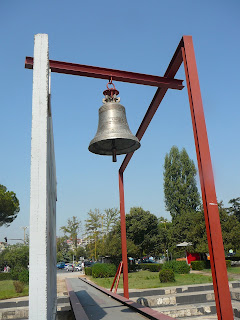
According to the Lonely Planet "if you haven't seen Ohrid, you haven't seen Macedonia" and I understand why because Lake Ohrid is spectacular. Situated on the Albanian-Macedonian border, Lake Ohrid is one of Europe's oldest and deepest lakes and covers an area of 138 square miles.
Luckily our bus ride to Macedonia went much smoother than the one to Albania and we were in Ohrid by early afternoon. We got dropped off on the main road in town and as we stood there looking completely lost, backpacks strapped on and map out, trying to figure out how to get to our guesthouse a man approached us and asked if we needed accommodation. Of course this happens often traveling and people are trying to get you to stay with them so we politely said we had a place to stay and went back to our map. He asked where and when we told him we were staying at Antonio Guesthouse he pulled out his phone and called Antonio to come meet us. Once we made it to our guesthouse (the house was shared by Antonio and his parents and they used some of the rooms upstairs for renting to travelers) we decided to relax for a bit and then headed out for dinner and a walk down to the harbor and through 'old town' with its lovely narrow cobblestone streets.
Upper Gate of Old Town Ohrid
On our second day in Ohrid we did Lonely Planet’s walking tour of Ohrid’s ‘old town’. We began our tour at Sveta Bogorodica Perivlepta church, which is home to some amazing frescos depicting the life of Mary (not picture allowed though) and on to the old town’s Upper Gate and Classical Amphitheater. The amphitheater was originally built for theater, but later the Romans pulled out the first ten rows to accommodate the gladiator fights. At the church we were given a tour about the history of the church and an explanation of what the frescos depict. According to Robby our tour guide reminded him of the gypsy woman Esmeralda from the Disney movie 'The Hunchback of Notre Dame'. She had long wild curly hair pulled back in a large jeweled butterfly clip and wore a long hot pink sundress and wedge sandals. Her tour style was animated and she spoke loudly with a very passionate tone about the subject matter of the frescos. When our tour first began there were four of us, but as more visitors came inside the church she had to tell them about the ticket price (she was only person working there) and she would yell to them that they could join our tour and pay later. Invariably when she went back to the tour instead of starting off where she had been she would quickly begin the story again.
Classical Amphitheater of Ohrid
Next we went to Car Samoil’s Castle. Car Samoil from Bulgaria ruled Macedonia from 980 AD to 1014 AD, until Byzantine emperor Basil II defeated Samoil at the Battle of Belasica in 1014. The castle offered panoramic views of the lake and city.
From the castle we wandered down a forest path to the ruins of a 4th century church, which is currently being excavated. Next to the ruins is the 5th century church of Sveti Kliment i Pantelejmon that displays the architectural style of the various empires that ruled Ohrid.
Sveto Kliment i Pantelejmon church
Walking back up the hill we made it to Sveti Jovan at Kaneo, a 13th century church, sitting on a cliff above Lake Ohrid.
Sveti Jovan at Kaneo church
Chapel of Mala Bogorodica
Below Sveti Jovan tucked into the cliff base is the small chapel of Mala Bogorodica sitting next to Kaneo beach. We stopped for a fish lunch at a beach café before finishing up our tour. After lunch we walked back up the hill towards the center of the old town to Sveta Sofija, an 11th century church that was modeled after Constantinople’s St. Sophia. Some of the frescos have been exposed from beneath the wall plastering that preserved them during the Ottoman era.
Sveta Sofija church
On our last day in Ohrid before our overnight bus to Belgrade we took a quick trip to Sveti Naum 29km from Ohrid on the other end of the lake. The Church of Sveti Naum is a multi-domed, Byzantine-style church and was built in the 16th century. Peacocks roam the grounds around the church (apparently peacocks were an early Christian symbol of resurrection and immortality. The peacock is also featured on the 10 Macedonian denar bank note and coin.
Church of Sveti Naum
Next Stop: Belgrade, Serbia

























